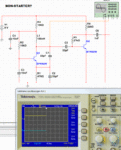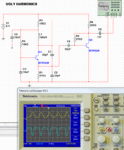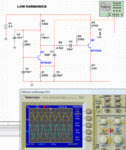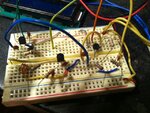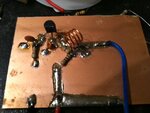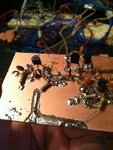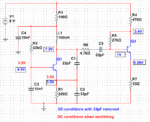Electrojosh86
Member level 3

- Joined
- Jun 20, 2013
- Messages
- 67
- Helped
- 0
- Reputation
- 0
- Reaction score
- 0
- Trophy points
- 6
- Activity points
- 570
 Hello, I am trying to build an RF FM Transmitter that transmits from 88 Mhz- 108 Mhz but I am having a very difficult time doing so. The transmitter I have tested works on a breadboard, which I read is not suppose to due to high capacitance, but for some reason and luck it does work. The problem is when I try and prototype it on a perfboard or anything else the damn thing will not work! The digital tuner part does but the oscillator does not. I have tried the "Manhattan" and "dead bug" construction styles on a PCB with the use of a ground plane and so far it will not work. It will oscillate, as I can sometimes hear on a receiver, but when I hook the PLL up it does not tune or do anything. I am at a loss as to what to do. Is there something I am missing, maybe shorter leads, longer leads, voodoo rituals and animal sacrifices? Or perhaps the oscillator needs to be designed better. I could use some help please. Attached is the schematic. For VT1 I am not using a BF199 I am using SS9018HBU RF transistor and I am aware that the 220k and 470k resistors in the oscillators should be in the ohms and not the kohm range, also thinking that the BFR91 transistor is backwards, corrected on breadboarded circuit and seems to work and for the varicaps I am using MV2109's as that is all I have. If anyone can help that would be awesome.
Hello, I am trying to build an RF FM Transmitter that transmits from 88 Mhz- 108 Mhz but I am having a very difficult time doing so. The transmitter I have tested works on a breadboard, which I read is not suppose to due to high capacitance, but for some reason and luck it does work. The problem is when I try and prototype it on a perfboard or anything else the damn thing will not work! The digital tuner part does but the oscillator does not. I have tried the "Manhattan" and "dead bug" construction styles on a PCB with the use of a ground plane and so far it will not work. It will oscillate, as I can sometimes hear on a receiver, but when I hook the PLL up it does not tune or do anything. I am at a loss as to what to do. Is there something I am missing, maybe shorter leads, longer leads, voodoo rituals and animal sacrifices? Or perhaps the oscillator needs to be designed better. I could use some help please. Attached is the schematic. For VT1 I am not using a BF199 I am using SS9018HBU RF transistor and I am aware that the 220k and 470k resistors in the oscillators should be in the ohms and not the kohm range, also thinking that the BFR91 transistor is backwards, corrected on breadboarded circuit and seems to work and for the varicaps I am using MV2109's as that is all I have. If anyone can help that would be awesome.


